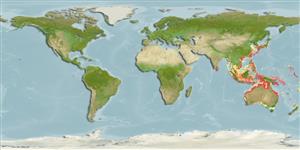Common names from other countries
Environment: milieu / climate zone / depth range / distribution range
Ecologie
marien demersaal. Tropical
Eastern Indian Ocean to Western Pacific: Australia and Indonesia.
Grootte / Gewicht / Leeftijd
Maturity: Lm ? range ? - ? cm
Max length : 45.0 cm TL mannelijk / geslacht onbekend; (Ref. 3132); max. gepubliceerd gewicht: 5.0 kg (Ref. 3132)
This species is distinguished by the following characters: a single small isolated dorsal spine anteriorly; second dorsal and anal fin rays usually 13; snout long, 28.5-31.0% HL; larger specimens with interorbit narrow 7.7-12.0% HL; postorbital short, 50.7-56.4% HL; posterior portion of snout and interorbital covered with scales; upper iris lappet triangular; skinny sensory tubes from the suborbital bones and preopercle not covering the cheek region; preopercule with 2 spines, the lower slightly longer than the upper; fingerlike interopercular flap; a single exterior opening of the lateral line scales; head and body pale brown, with many small brownish spots dorsally, 4 or more dark longitudinal bands on caudal fin, and upper lobe of caudal fin lacking yellow blotch when fresh (Ref. 86914).
Found on sand bottoms (Ref. 3132). Neither anterolateral glandular groove nor venom gland is present (Ref. 57406).
Levenscyclus en paargedrag
Maturities | Voortplanting | Spawnings | Egg(s) | Fecundities | Larven
Imamura, H., 2008. Synonymy of two species of the genus Platycephalus and validity of Platycephalus westraliae (Teleostei: Platycephalidae). Ichthyol. Res. 55:399-406. (Ref. 86914)
Status op de Rode Lijst van het IUCN (Ref. 130435)
CITES (Ref. 128078)
Not Evaluated
Gebruik door de mens
Tools
Speciale rapporten
Download XML
Internetbronnen
Estimates based on models
Preferred temperature (Ref.
115969): 21.5 - 28.8, mean 27.7 (based on 528 cells).
Fylogenetische diversiteitsindex (Ref.
82804): PD
50 = 0.5000 [Uniqueness, from 0.5 = low to 2.0 = high].
Bayesian length-weight: a=0.00525 (0.00246 - 0.01120), b=3.04 (2.85 - 3.23), in cm Total Length, based on LWR estimates for this (Sub)family-body shape (Ref.
93245).
Trofisch niveau (Ref.
69278): 4.4 ±0.7 se; based on diet studies.
Weerstandsvermogen (Ref.
120179): Gemiddeld, minimale populatieverdubbelingstijd 1,4-4,4 jaar (Preliminary K or Fecundity.).
Fishing Vulnerability (Ref.
59153): Low to moderate vulnerability (35 of 100).
